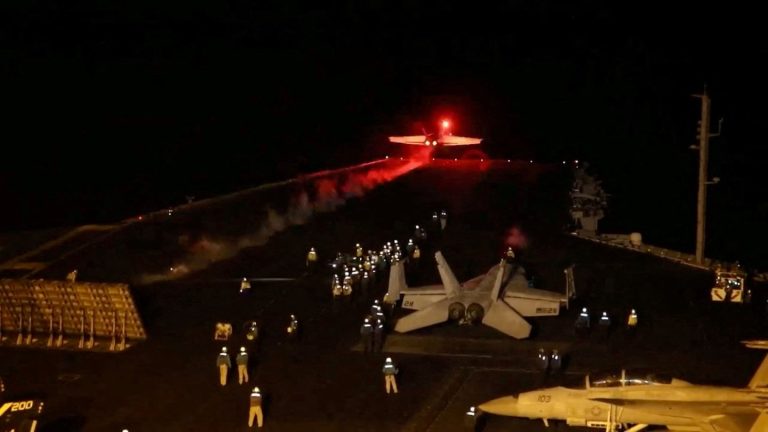The second wave of airstrikes was a necessary self-defense measure after US forces noticed additional Houthi weapons during their nighttime offensive, the official, Lt. Gen. Douglas Sims, told reporters on Friday. He added that the targets included radar stations, drone and missile launch sites, and storage warehouses. Sims noted that more than 150 munitions combined were used to destroy dozens of sites, adding that damage assessment is ongoing.
After the strikes, another ballistic missile was launched from Yemen but failed to hit any ships, Sims said.
Thursday's operation, involving a consortium of air and naval forces led by the United States and Britain, exacerbated fears that Israel's war in Gaza will extend beyond the blockaded Palestinian enclave and engulf the region in violence. Indeed, Israel and Hezbollah exchange fire on an almost daily basis on the Lebanese border. Although Hezbollah, an Iranian proxy, has so far stayed away from escalation, the Houthis have seized the opportunity to position themselves as defenders of Gaza.
As thousands gathered on Friday in the Yemeni capital, Sanaa, to protest the previous night's attack, Houthi military spokesman Yahya Saree said the strikes would not go “without punishment or response” and stressed in a video message that the group would not be deterred.
Sarie said that 73 raids hit Sanaa and four other areas, killing five of the group’s fighters and wounding six. These allegations could not be independently verified.
Sims said the operation “was not about casualties as much as it was about weakening capabilities,” believing that the Houthis “are now trying to figure things out on the ground and determine what capabilities they still have.” The United States has not yet publicly stated how many people may have died as a result.
In Washington, some on Capitol Hill expressed concerns that the Biden administration had bypassed Congress by allowing the process without lawmakers' approval. In a notice to Congress issued by the White House on Friday, President Biden said the strikes were in response to ongoing attacks that have threatened US and British military ships and endangered key trade routes, and were designed to weaken the Houthis' capacity. To sustain such activity.
Although the Houthis have been blamed for more than two dozen incidents in the Red Sea dating back to November, officials said the turning point was their complex attack last Tuesday. The United States and its partners issued an ultimatum to the Houthis in response, but the cease-and-desist warning was ignored.
Biden's notification to Congress described the operation as a “proportionate measure consistent with international law.” He cites the United States' “inherent right” to self-defense as outlined in the United Nations Charter. US officials also sought to stress that Australia, Bahrain, Canada and the Netherlands supported the operation.
Biden said he “will not hesitate to direct further measures to protect our people and the free flow of international trade.” But it remains to be seen what the Houthis may be able to do after Thursday's military action.
Sims said he doubted the group's ability to carry out an attack similar to the one that occurred earlier this week. “But we'll see,” he added.
Four Typhoon fighter jets bombed two sites used to launch drone and missile attacks, a senior British official, Armed Forces Minister James Hebbey, said on Friday. Heby told the BBC that no further strikes were “immediately planned”.
The Houthis operate as a de facto government in the areas they control in Yemen. This includes a strategically important area on the Bab el-Mandeb Strait, which is a shipping choke point between the Indian Ocean and the Suez Canal, and key to trade between Asia, Europe and the United States.
Its attacks forced some container ships to reroute thousands of miles and spend more money on fuel and insurance, disrupting trade and pushing up commodity prices.
Some observers predicted that the limited air strikes would have little impact on the guerrilla force built up by the Saudi-led air campaign nine years ago, and instead increase the risk of escalation.
Omani Foreign Minister Badr al-Busaidi said the strikes “contrary to our advice and will only exacerbate a very dangerous situation.”
Saudi Arabia, which is trying to conclude a peace agreement with the Houthis in the conflict that began in 2015, is closely monitoring events in the Red Sea and inside Yemen “with great concern,” the Saudi Foreign Ministry said in a statement.
Iran, which has avoided direct confrontation with the United States since Hamas attacked Israel on October 7, is the one that sparked the war in Gaza, calling the strikes “a clear violation of Yemen’s sovereignty and territorial integrity.”
Iranian Foreign Ministry spokesman Nasser al-Kanani said that the United States launched the strikes to “distract the attention of the people of the world” from the war in Gaza.
The governments of Australia, Bahrain, Canada, Denmark, Germany, the Netherlands, New Zealand, South Korea, Britain and the United States said the strikes “demonstrated a shared commitment to freedom of navigation, international trade and defending the lives of seafarers from enemies.” Unlawful and unprovoked attacks.”
Victoria Bissette, Andrew Jeong, Dan Lamothe and Adam Taylor contributed to this report.

